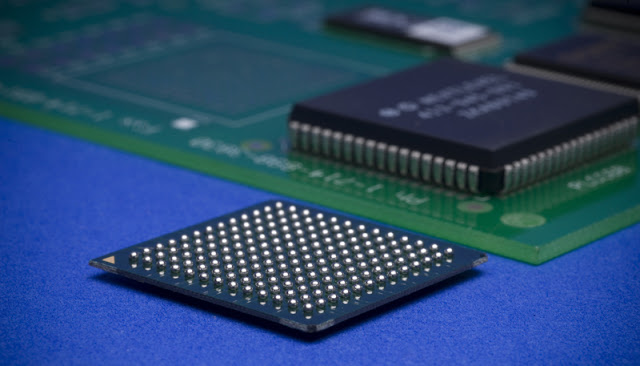Why Flip chip Technology is Getting Popular
In the evolution of the packaging of electronics, the aim is to improve the density of packaging, lower cost, and increase performance. A chip of semiconductor is set up face down into the circuit board is perfect for size considerations as there is no extra space needed for contacting on the sides of the component. And this is done while increasing the reliability of the circuits. The whole process is known as flip-chip technology.
In the typical packaging process, the interconnection between the carrier and the die is set up by using a wire. The die is then connected to the carrier, and then a wire is bonded first to the die, then looped and bonded to the carrier. The length of wires is typically 1-5mm.
On the other hand, in flip-chip technology, the interconnection between the die and the carrier is set up through a bump which is located on the die surface. The height of the bump is typically 0.06 to 0.1mm.
Flip-chip technology: Let’s know it from Scratch
Flip-chip is not a recently developed technology. Flip-chip technology has been developed by IBM Corporation since the 1960s to supply the connection between bonding pads of the chips and the metallization on the substrate. It is the first proposed method called the Controlled Collapse Chip Connection (C4) to displace wire bolding, expanded IO density, and cost reduction.
The C4 process begins with sticking under bump metallurgy (UBM) on the bonding pads of chips to provide a good union between the bonding pads and the bumps. Generally, UBM consists of three layers of barrier and/or adhesion layer, wetting layer, an oxidation barrier layer.
The performance in high-frequency applications of flip-flop technology is superior to other methods. This is achieved because flip flop technology minimized the length of the connection path. Moreover, due to the reduced number of connections, the reliability is better than with packaged components. There is only one level of joining connection between the chip and the circuit board in flip-chip technology.
In the advances of the packaging of electronics, the goal is to increase the density of packaging, lower cost, and improve performance. And this is done while increasing the reliability of the circuits. A chip of semiconductor is set up face down into the circuit board is perfect for size considerations as there is no extra space wanted for contacting on the sides of the component.
Benefits of Flip-chip Technology
Increased functionality: The use of flip flop provides an increment in the number of I/O. Unlike in wire bonding, I/O is not limited to the perimeter of the chip. 400 pads can easily be handled by a flip-chip.
Technical thresholds: Latest flip-chip designs are in production with 5900 bumps/chips at 0.2 mm pitch and 500 bumps/chips at 0.17mm pitch in area array configurations. Area array pitches in future production will continue to reduce to 0.15mm in the years to come as the technology of substrate becomes cost-effective.
Reliability: Flip-chip processes include placement, reflow, and fluxing, as well as the dispensing process and underfill material. Underfill material is generally required on laminate substrates to eliminate solder fatigue in flip-chip technology. A well-characterized flip-chip assembly process can achieve high reliability and yields.
Reduced Cost: Cost analyses and comparisons are dependent on the choice of substrate technology and modeling conditions. Flip-chip technology offers cost reductions in batch bumping processes and the underfill process.
Opportunities in the Future
Today flip-chip technologies are widely used in hearing aids, LCDs, automotive engine controllers, watches, mobile phones disk drivers, portable communications as well as in mainframe computers.
Flip-chip technology is comparatively cheaper than wire bonding. It is because bonding of all connections in the flip-chip system takes place simultaneously while one bond is made at a time in wire bonding technology.
Low cost, performance, and other beneficial factors have become the key drivers for the adoption of flip-chip technologies.
Flip-chip will continue to exist as growing technology in the coming future. It will continue to redefine the continuum of product and process solutions for the interconnection of the die to the exterior world.
Flip-chip technology has been there since the 1960s, it is still prevalent today. There are many technical and other variations in this technology with a different maturity level. Improvements are underway that will apply a backside lamination coating (BSL). This will protect the less active side of the die against mechanical impact and light. Moreover, BSL will improve the readability of the laser marking under bright field illumination.
Conclusion
As a flip-chip infrastructure is established, the cost will be reduced and the application space will broaden. Various factors from the Silicon industry have been the driver for the growth of flip-chip technology. The flip-chip market is in a growing phase and we hope it will flourish more in the future.
Today flip-chips remain a novel development with a big scope for further growth. Developments in the technology of semiconductors have created flip-chips with transistor counts and functions that were difficult to imagine a few years ago. Today flip-chips are available in various ranges of pitches to meet the demands and needs of specific applications. Owing to its benefits, this technology continues to hold a significant advantage over the other microelectronic packaging.
Flip-chip technology continues to develop and has an important role to play in various domains. It can adapt to the current challenges due to recent developments in bumping solutions that serve the most advanced packaging technologies. Flip-chip has been developed by electroplating or pastes printing processes.
New developments in the low-cost package and high-density substrates have promoted the growth and use of flip-chip applications. Flip-chip technologies have been extensively used for the processors of smartphones, tablet games, personal computers, and servers, etc.


Comments
Post a Comment